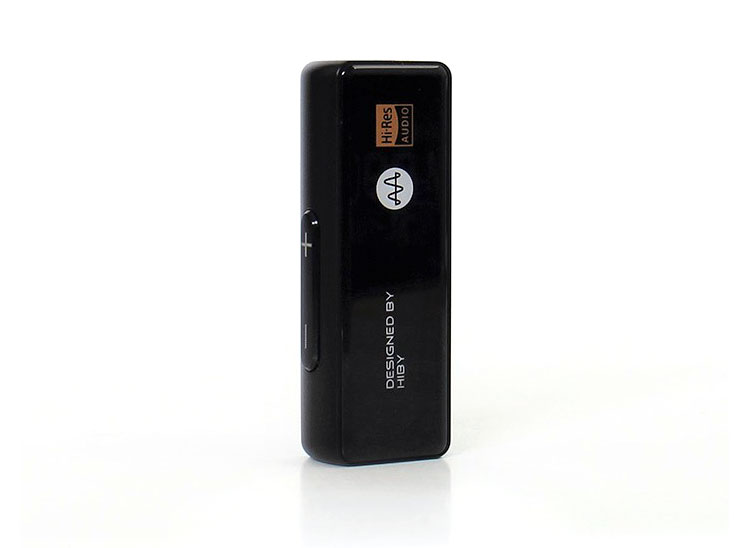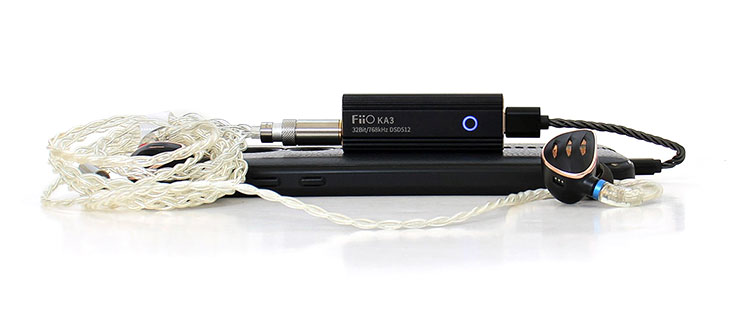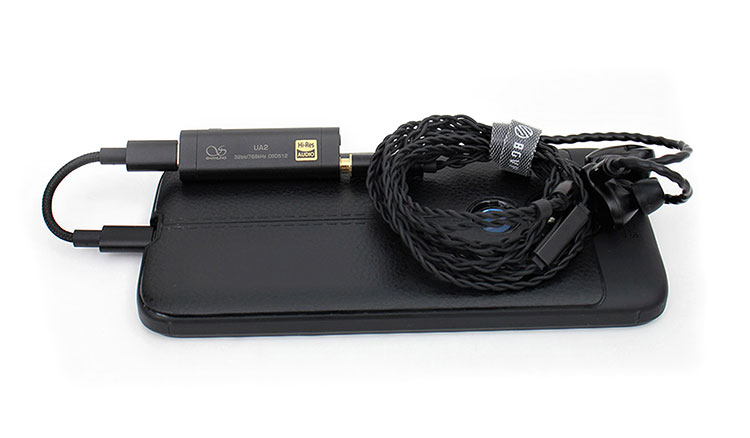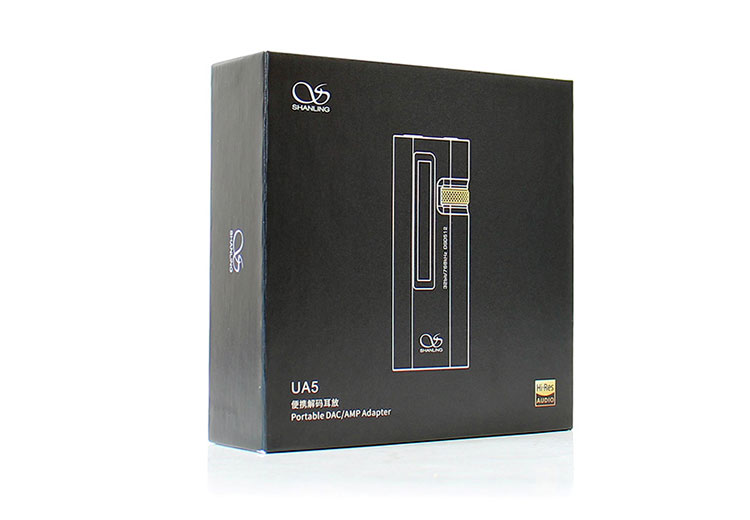Sound Impressions
One of the most obvious characteristics to me and to my liking is the intimacy and warmth you get from this dongle DAC. The sound signature is a slightly wide, warm fuzzy ball of sound. I mostly listened to the DAC in Apodizing mode because this filter seems to remove some of the edginess of certain peaks in tracks.
Don’t mistake intimacy in this case for narrow, however. The soundstage presented is medium in size with some good placement capability but it seems to sonically display an inward character that gives sounds a forward presence but keeps them so in a cohesive manner.
Another characteristic that is apparent is the dark background and low noise floor. It seems the hybrid battery system removes lots of the dirt that transfers to dongles from most USB connections and it allows for a cleaner overall end result and a darker character. I tried to get the UA5 to produce some hiss and it was rather hard to do so, especially on a low gain setting.
The frequency response front to back seems to be evenly represented with a good top and bottom extension although I would say best on top than the bottom end response as the specs indicate since it seems to drop off the radar right below that specified 20 Hz but is not recessed until it reaches 22 Hz.
Bass response music-wise is ample enough and is not deficient. I used well-known headphones that can take me down to 14 Hz audibly.
Synergy
Power
I was rather happy running the Shanling UA5 and the HIFIMAN Sundara using the 4.4mm side but not so much off the single-ended side.
The Shanling UA5 could push them well and loud enough as I need them to go but at the very top of the volume there was some breakage but that was expected since this device is not a high current device technically.
If you use that as a guide there are only a handful of headphones the UA5 can’t push hard enough to satisfactory loud levels.
You would probably be happy with most dynamic driver headphones out there but there might be some 600Ω models and some hard-to-drive planar magnetic cans that I would not combine the UA5 with. So the rule of thumb here is to use efficient headphones.
Pairing
I played around some with the selectable DAC filters and there are some that cater to full-size headphones and some cater to IEMs. For example, the in-ear fast and in-ear slow settings are just that.
The setting is best for IEMs and the filter tries to better match the latency between the ears and the output stem contrary to headphones in which the driver sits further away from the ear canal.
The feature I like the most about the UA5 filter set is the way it accommodates most types of headphones and IEMs but it also customizes sound somewhat and gives the user option to obtain a preferred sound making this dongle DAC very versatile for pairings.
Select Comparisons
HiBy FC5
$159.00
Technical
The HiBy FC5 went with a different strategy than the UA5. Instead of double DAC chips, they chose a single ES9281PRO. One advantage this chip and device has is the MQA capability but it lacks other features like selectable filters and a hybrid battery.
The HiBy FC5 is basically a bare-bones model with a flagship BT chip, volume control, and a 4.4mm connection and it comes with a 4.4mm to a 3.5mm adapter which confused me some since balanced circuitry is not supposed to share the ground lead technically.
Then I used this same adapter on some other 4.4mm equipped dongle DACs and it worked so I’m still scratching my head here.
Design
The FC5 is slightly smaller in size but it does not have a screen and a 3.5mm connection. Price-wise the FC5 also carries a smaller tag albeit with fewer features but that might be okay for those who want simple over complex.
The HiBy FC5 uses a USB-C connector on the back end and the front end has that single 4.4mm connection, a rocker-type volume control, the end. The device is simple and to the point. It does have a small LED slit that displays color according to the digital format.
Performance
I was listening to some Steely Dan Slang of Ages writing this section and I heard a couple of nuances I could not hear on the other dongle DACs and this is where the strong point of the FC5 lies. It produces an ample amount of detail and it seems the premium label on the chip is not just fluff.
It seems to be the more delicate listen but just the same if you decide to get it and decide to go party mode and turn up the volume it will tend to run out of steam especially if you use a somewhat demanding headphone.
Both these DACs tend to veer to a warm sound signature but more so on the UA5 especially with the Apodizing filter on. The UA5 output does seem to have a small amount of extra drive power over the FC5. But if you listen to both models at the same volume level, in a blind test I bet you hardly any out there would have the ability to tell the difference.
FiiO KA3
$89.99
Technical
The FiiO KA3 is different from the HIBY for example in that it has onboard 3.5mm and 4.4mm ports with no need for an adapter. It also has more available power and is rated at 240mw at the same 32 ohms. This puts it on par with or surpasses the UA5 in power output.
And just like the UA5, the KA3 does PCM 32 bit / 768 kHz and DSD512 with no MQA capability so once again for less you seem to get more if you look at power output specs alone.
One common feature the KA3 and the UA5 have is that both use the same ES9038Q2M chip. FiiO doesn’t double up and only uses one while the UA5 uses two in a dual mono design. They have the same PCM and DSD format capabilities, however.
Design
The FiiO KA3 is also constructed of metal including both end caps but it uses a black and gold theme which is rather classic looking. However, I think the all-black will stand the test of time best far as styling and when it comes to design appeal.
The slightly finned body style of the KA3 does allow an extra amount of cooling but the FiiO KA3 rarely gets warm and never gets hot even when the music gets hot.
What I found most peculiar about the KA3 design is that if you flip it, you get a view of the FiiO branding, flip it over again and you see Jade Audio branding as if the dongle was made by two companies. In fact, FiiO is the parent company of Jade Audio and the KA3 was a joint venture designed dongle DAC between the two companies.
Performance
The FiiO KA3 definitely has a more laid-back and soft-mannered presentation. It also has the most introverted character of the bunch and seems to portray an intimate space where all the music happens and all within a smaller soundstage.
Sure, both devices use ESS and have an overall warm character but since the UA5 has those selectable digital filters, this can give you some fine-tuning abilities and hence, a better ability to pair properly.
Shanling UA2
$85.00
Technical
The Shanling UA2 is the smallest of the group but it does not lack features. It uses the same ES9038Q2M chip but the amp section was swapped out for a Ricore RT6863 operational amplifier in this device.
Since the DAC chip is the same most of the specifications stay the same. The UA2 has the same 32-bit 768 kHz and DSD512 capability but again, no MQA.
Design
The Shanling UA2 case is all metal including the end caps. There is one USB-C connection at one end but the UA2 throws a twist at us by incorporating a 3.5mm SE and a 2.5mm balanced output instead of the more common 4.4mm.
The UA2 is the least heavy, the smallest in this comparison so if you want something small then this one should be chosen over the other models. The Shanling UA2 does not have a volume control but it has a small button on its side that kicks the unit into compatibility mode or UA mode.
Performance
Don’t let the size fool you here because the Shanling UA2 is capable of 195mW of power but only on the 2.5mm balanced connection which is becoming more uncommon than the 4.4mm. I think the one that will stand the test of time is the 4.4mm but that’s just my opinion.
Both DACs sound rather warm and have the same ESS characteristics and although the UA2 is very enjoyable I prefer the UA5 overall in sound quality by a small margin.
It seems to present a smoother character and since the UA2 lacks the selectable filter the sound you get is all you get which is not bad by all means but of course features, in general, make a product better, well not all the time.
Our Verdict
I think that last line sums it up. Yes, the Shanling UA5 is a dongle DAC that carries a premium cost but it has lots of features besides having one of the best sounding component stages with a clean output.
I purposely compared dongle DACs that decline in price tag and features because I wanted to demonstrate one point that could be summed up by the common phrase of you get what you pay for.
Features like the hybrid battery, selectable DAC filters, good driving power, dual headphone outs, and volume controls that do so much plus a great sounding signature all make the Shanling UA5 a very formidable DAC and worthy of its ante.
Shanling UA5 Specifications
- Dimensions 5mm
- Weight 29 grams
- HI-Res Support Up to 32 bit / 768 kHz and DSD152
- DAC 2 ESS ES9038Q2M
- Digital Filters User Selectable from 7 Options
- Battery 220 mAh
- Battery Life 6 Hours 3.5mm Output / 3 Hours 4.4mm Out
3.5mm single-ended Output
- Power 1V @32 Ohms ( 137mW )
- Frequency Response 20Hz to 50 kHz
- THD+N 0005% @32 Ohms A-weighted
- Dynamic Range 122DB @32 Ohms
- Channel Separation 77dB @ 32 Ohms
- SN ratio 121dB @32 Ohms A-weighted
- Output Impedance 8 Ohms
4.4mm Balanced Output
- Power 6 Volts @ 32 Ohms ( 211mW )
- Frequency Response 20Hz to 50kHz (-0.5DB)
- THD+N 005% @ 32 Ohms A weighted @ 1V
- Dynamic Range 120dB @ 32 ohms A-weighted
- Channel Separation 110dB @ 32 Ohms
- SN Ratio 116dB @32 Ohms A-Weighted
- Output Impedance 6 Ohms
- 5mm SPDIF Coaxial Output
- Support of up to 24 bit 192kHz
- 5mm TRRS Standard







